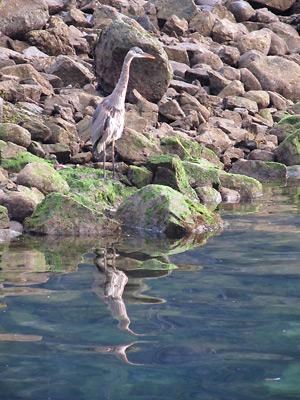Concerns are being raised about the number of great blue heron (Ardea herodias) living on BC’s south coast and wildlife conservationists are looking for the public’s help to determine how many of the birds live in the Powell River area.
Tamsin Baker is a stewardship coordinator for South Coast Conservation Program (SCCP), a partnership that works to protect ecosystems and species on BC’s Lower Mainland, Sea-to-Sky corridor and Sunshine Coast. Baker visited Powell River on Thursday, February 26, to speak to the Malaspina Naturalists’ Club about SCCP’s heron project.
Baker said the SCCP has partnered with the province to spread word about the actions needed to protect the heron’s coastal populations.
Up and down the BC coast, the at-risk birds are busy building nests and raising their young together in colonies called heronries.
“It turns out that even though we see herons at the ocean feeding all the time, they are not doing so well,” Baker said, explaining that recent data suggests a drop in the number of herons on the Sunshine Coast. “There’s not as many as we would like. What we would like is some help to find out more about the herons.”
Herons on the Sunshine Coast tend to nest in smaller colonies that include between two to four nests, Baker said.
“The more we know about their success in nesting, the better we can understand what is happening,” she added.
Baker said biologists have been monitoring sites over the years in the Powell River area, but she is sure there are ones on private land that have been missed.
The reason for the heron’s declining numbers, said Baker, is thought to be from a combination of factors including human disturbance, loss of habitat due to development and predation from bald eagles.
There are a couple of ways the public can assist in protecting the herons, she said. The biologists are trying to collect information about nesting site locations. Herons prefer to build their large stick nests high up in mature trees and return each year if undisturbed. These nests are often camouflaged by foliage, so March is a good time to look for the nests, before leaves sprout.
Documenting work has already been started for the protected species and biologists have created an online map of nest locations. The Great Blue Heron Atlas can be found online.
Herons are sensitive to disturbances during breeding season which can lead to the birds abandoning established nests. These disturbances can include walking too closely to the nest or loud noise from equipment.
Herons are protected under the BC Wildlife Act and the ministry of environment recommends establishing a buffer zone around the nests, between 60 to 300 metres radius depending on the area.
For those interested in learning about how to monitor active nests, more information can be found on SCCP’s website.
Baker is asking anyone observing an active heron nest or having questions about the birds to contact her at [email protected] or call 1.604.202.2381.



